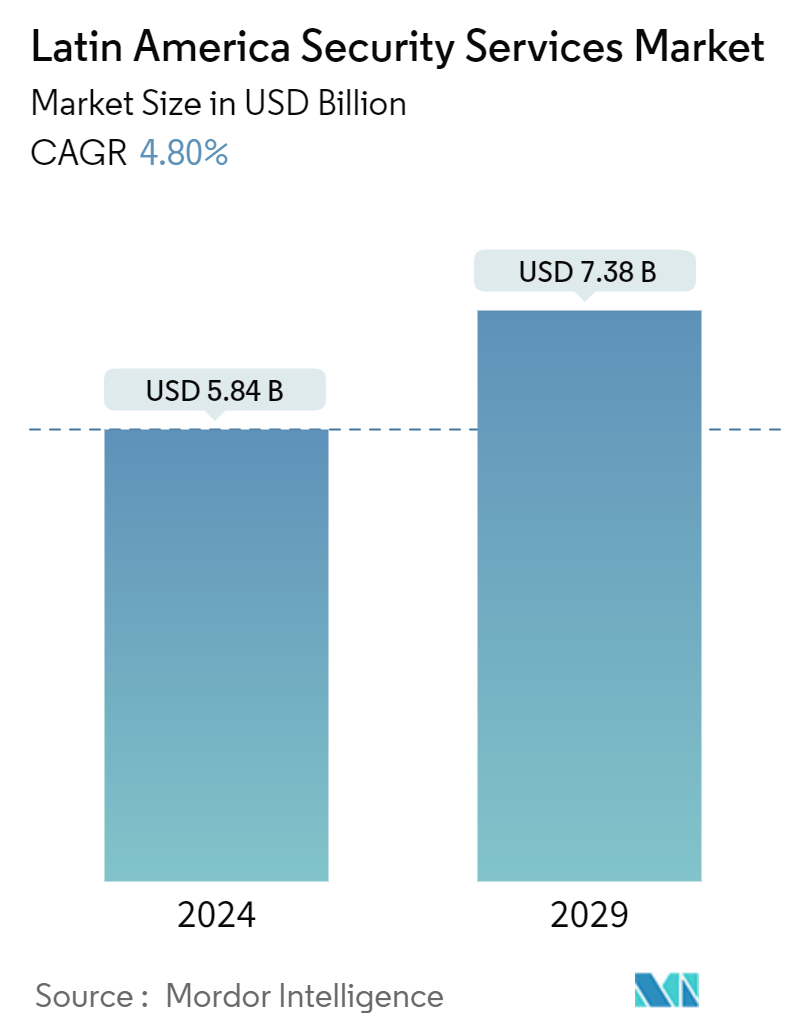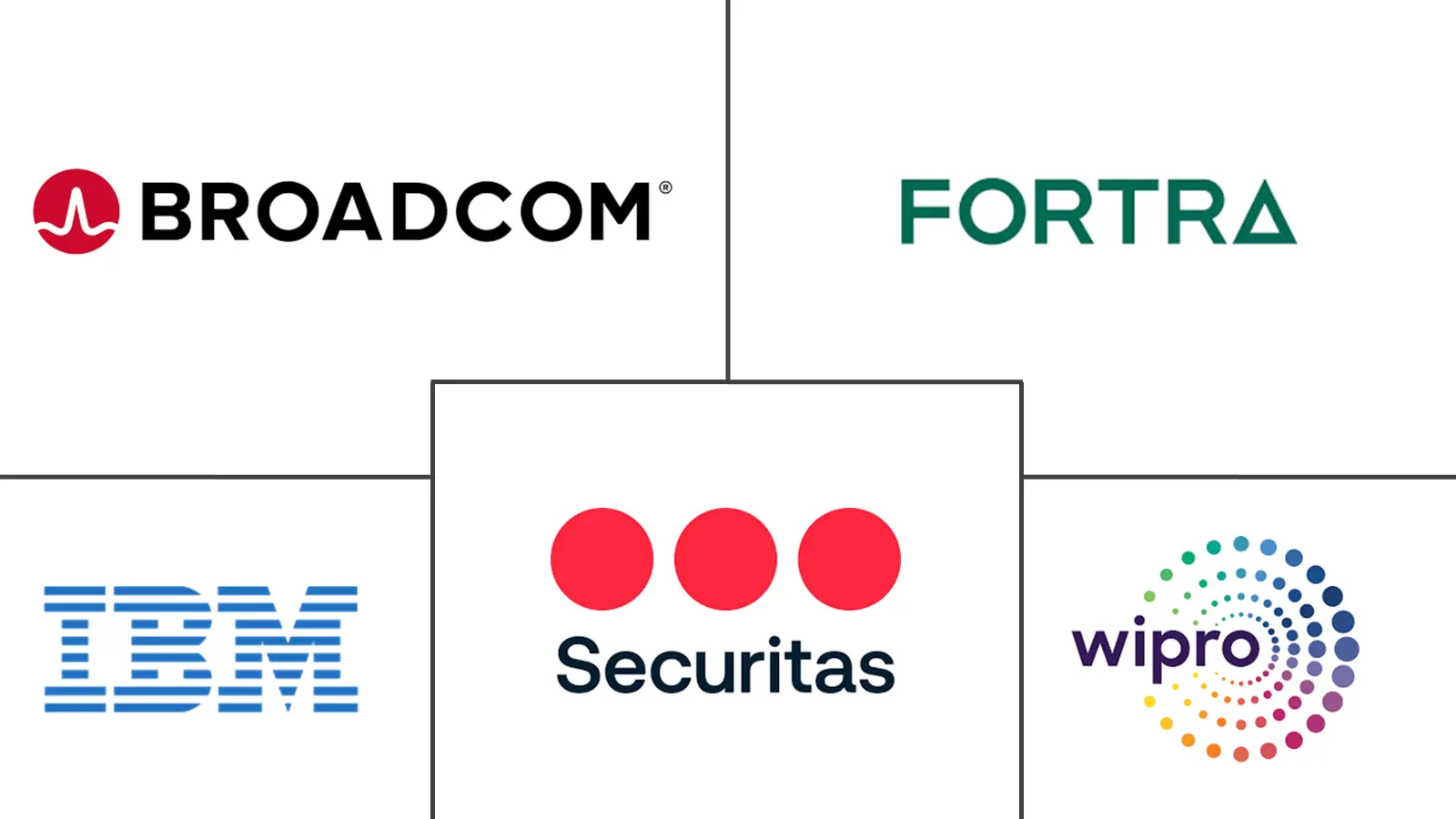Market Size of Latin America Security Services Industry

| Study Period | 2022 - 2029 |
| Base Year For Estimation | 2023 |
| Market Size (2024) | USD 5.84 Billion |
| Market Size (2029) | USD 7.38 Billion |
| CAGR (2024 - 2029) | 4.80 % |
| Market Concentration | Low |
Major Players
*Disclaimer: Major Players sorted in no particular order |
Latin America Security Services Market Analysis
The Latin America Security Services Market size is estimated at USD 5.84 billion in 2024, and is expected to reach USD 7.38 billion by 2029, growing at a CAGR of 4.80% during the forecast period (2024-2029).
- Security services encompass a variety of services aimed at improving an organization's defense against cybercrimes like ransomware, malware, and phishing. These services include consulting, integration, design, professional training, and risk assessment. Companies in Latin America are leading the way in global security operations with the advanced use of innovative emerging technology. Growing awareness of security threats, including cybercrime, terrorism, and organized crime, prompts individuals and organizations to invest in security services to safeguard against potential risks.
- For instance, in October 2023, according to G4S limited, security service providers expect that both internal and external risks to businesses will rise and continue to be higher than global averagesa. One of the main external threats is expected to be fraud, according to 29% of companies surveyed. Mexico, Brazil, and Colombia have the highest expectations of this threat, with 37%, 33%, and 30%, respectively, exceeding the global average of 25%. In addition, 50% of respondents attributed the increase in security budget to higher operational costs, while 47% cited international economic instability.
- Compliance with security regulations and industry standards, particularly in sectors such as banking, finance, and critical infrastructure, fuels the demand for security services to meet legal obligations and protect sensitive information. For instance, in August 2023, HCLTech, a technology company, introduced a cybersecurity center in Guadalajara, Mexico. This center is specifically designed to cater to the changing security needs of multinational businesses in interconnected environments. With the utilization of HCLTech's Universal Managed Detection and Response solution, established frameworks, and a proficient team of security specialists, the new cybersecurity facility in Mexico will focus on promptly identifying and addressing potential threats.
- Despite the demand for security services, the pervasive nature of crime in Latin America, including violence and organized crime, presents significant challenges for security service providers. Persistent crime rates can undermine confidence in the effectiveness of security measures. Moreover, inadequate regulation and enforcement of security standards in certain countries may lead to a proliferation of unlicensed or poorly trained security providers, undermining the industry's credibility and reducing trust in security services.
- Macroeconomic factors, such as economic fluctuations, can affect the government budgets allocated for security services and private sector spending on security measures. The region's political instability or unrest can impact security conditions and the demand for security services. In addition, the changes in government regulations related to security, law enforcement, and data protection can impact security services.
- Infrastructure projects like transportation networks and critical infrastructure facilities may require security services to protect against the potential threat. Services encompass multiple services to improve an organization's defense against cybercrimes like ransomware, malware, and phishing. These services include consulting, integration, design, professional training, and risk assessment.
Latin America Security Services Industry Segmentation
Security services are processes or comprehensive services that improve an organization's protection and security against common cyberattacks, including phishing, malicious software, and ransomware. These services encompass design and integration, deployment, risk and threat analysis, and consultation. Managed and hosted security services and solutions can be supplemented using cloud services, artificial intelligence (AI), biometrics, Internet of Things (IoT), and other remote services.
The Latin American security services market is segmented by service type (managed security services, professional security services, consulting services, and threat intelligence security services), mode of deployment (on-premise and cloud), end-user industry (IT and infrastructure, government, industrial, healthcare, transportation and logistics, banking, and other end-user industries), and country (Brazil, Mexico, Argentina, and Rest of Latin America). The market sizes and forecasts are provided in terms of value (USD) for all the above segments.
| By Service Type | |
| Managed Security Services | |
| Professional Security Services | |
| Consulting Services | |
| Threat Intelligence Security Services |
| By Mode of Deployment | |
| On-premise | |
| Cloud |
| By End-user Industry | |
| IT and Infrastructure | |
| Government | |
| Industrial | |
| Healthcare | |
| Transportation and Logistics | |
| Banking | |
| Other End-user Industries |
| By Country*** | |
| Brazil | |
| Mexico | |
| Argentina | |
| Colombia | |
| Chile |
Latin America Security Services Market Size Summary
The Latin America security services market is poised for significant growth, driven by the increasing awareness of security threats such as cybercrime, terrorism, and organized crime. This awareness is prompting both individuals and organizations to invest in a range of security services, including consulting, integration, design, professional training, and risk assessment, to safeguard against potential risks. The market is characterized by the adoption of innovative emerging technologies, with companies in the region leading global security operations. Compliance with security regulations and industry standards, particularly in sectors like banking, finance, and critical infrastructure, is further fueling demand. Despite the challenges posed by pervasive crime and inadequate regulation in some areas, the market is expanding due to the rising need for robust security measures to protect assets, infrastructure, and sensitive information.
Mexico stands out as a key market within the region, driven by its large size, advanced industries, and increasing private sector investment in security services. The Mexican government's initiatives to combat crime and enhance public safety, along with the growing economy and expanding industries, are creating a strong demand for security services. The rise in internet activity and cyberattacks has emphasized the need for managed security services, prompting businesses to invest in comprehensive security measures to ensure compliance with evolving regulatory requirements. The market is fragmented, with major players like Broadcom, Securitas Inc., Fortra LLC, Fujitsu Ltd, and IBM Corporation actively expanding their presence through collaborations, partnerships, and acquisitions. These strategic moves are aimed at enhancing their service offerings and responding to the changing market dynamics, thereby driving the growth of the security services sector in Latin America.
Latin America Security Services Market Size - Table of Contents
-
1. MARKET INSIGHTS
-
1.1 Market Overview
-
1.2 Industry Attractiveness - Porter's Five Forces Analysis
-
1.2.1 Bargaining Power of Suppliers
-
1.2.2 Bargaining Power of Consumers
-
1.2.3 Threat of New Entrants
-
1.2.4 Threat of Substitutes
-
1.2.5 Intensity of Competitive Rivalry
-
-
1.3 Impact of COVID-19 Aftereffects and Other Macroeconomic Factors on the Market
-
-
2. MARKET SEGMENTATION
-
2.1 By Service Type
-
2.1.1 Managed Security Services
-
2.1.2 Professional Security Services
-
2.1.3 Consulting Services
-
2.1.4 Threat Intelligence Security Services
-
-
2.2 By Mode of Deployment
-
2.2.1 On-premise
-
2.2.2 Cloud
-
-
2.3 By End-user Industry
-
2.3.1 IT and Infrastructure
-
2.3.2 Government
-
2.3.3 Industrial
-
2.3.4 Healthcare
-
2.3.5 Transportation and Logistics
-
2.3.6 Banking
-
2.3.7 Other End-user Industries
-
-
2.4 By Country***
-
2.4.1 Brazil
-
2.4.2 Mexico
-
2.4.3 Argentina
-
2.4.4 Colombia
-
2.4.5 Chile
-
-
Latin America Security Services Market Size FAQs
How big is the Latin America Security Services Market?
The Latin America Security Services Market size is expected to reach USD 5.84 billion in 2024 and grow at a CAGR of 4.80% to reach USD 7.38 billion by 2029.
What is the current Latin America Security Services Market size?
In 2024, the Latin America Security Services Market size is expected to reach USD 5.84 billion.

